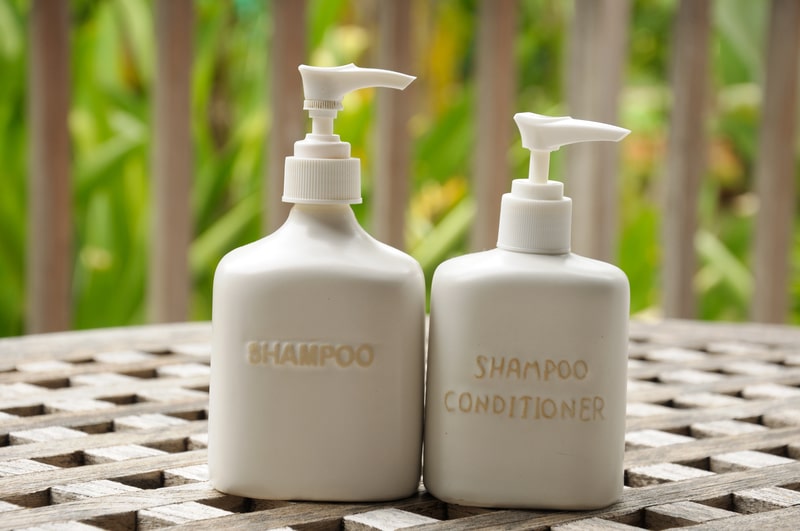
Conditioners play a key role in getting you ready to face the world each day. They make the unbrushable brushable. They tame those spastic fly-aways and add shine. We’re not here to take them away from you, but we do want to help you make some healthier choices, given the ingredients in typical conditioners are not nearly as safe as you probably think they are. In all likelihood, the conditioner sitting in your shower right now contains endocrine-disrupting & possibly carcinogenic chemicals that can actually get into your skin instead of innocently washing down the drain. You may not immediately notice the adverse health effects of smearing toxic chemicals on your scalp every day, but the effects add up. Making the switch to non toxic conditioners can make a big difference in a short period of time for both you and your family. For example, teenage girls who switched to personal care products without parabens and phthalates saw the level of these toxic substances in their bodies plunge in only 3 days after making the switch. Read on to learn about the top 5 ingredients to avoid in order to switch to a more toxic chemical free conditioner.
How to Choose a Chemical Free Conditioner: The Top 5 Ingredients to Avoid
1. Cocamidopropyl Betaine – Cocamidopropyl betaine is a surfactant and an anti-static agent. It’s in a lot of hair conditioners because it’s also a hair-conditioning agent. This ingredient can cause irritation or allergic dermatitis which might be due to the cocamidopropyl betaine itself, or the presence of contaminants like 3-dimethylaminopropylamine. To avoid cocamidopropyl betaine, skip any conditioners listing these ingredients: CADG; Cocamidopropyl betaine; Cocamidopropyl dimethyl glycine; Cocoamphocarboxypropionate; Cocoamphodiproprionate; Disodium cocoamphodipropionate; N-(Coco alkyl) amido propyl dimethyl betaine; Coconut oil amidopropyl betaine; Quaternary ammonium compounds, (carboxymethyl)3-cocoamidopropyl)dimethyl, hydroxides, inner salts; 1-Propanaminium, 3-amino-N-(carboxymethyl)-N,N-dimethyl-, N-coco acyl derivs., inner salts.
2. Parabens – Parabens are a family of ingredients that are used in lots of products including conditioners. They’re xenoestrogens that can cause hormone disruption, reproductive toxicity, developmental toxicity, and cancer. To avoid parabens, skip conditioners with ingredient names that contain the word “paraben”. Examples include: methyl paraben, propylparaben, ethylparaben, and butylparaben.
3. Fragrances – We know the fragrances in conditioners make it seem like the conditioner is making your hair healthier. But you should know that the fragrance chemicals aren’t actually adding to the performance of the conditioner, and instead are introducing major health risks to you. Fragrance chemicals can pass through the skin and many of the chemicals in fragrances are classified as allergens, hormone disruptors, and asthma triggers, carcinogens or neurotoxins.
The regulation around fragrance safety is shockingly lax. The fragrance industry regulates itself, so the ingredients in fragrances aren’t listed because they are considered “trade secrets” and aren’t required to be safety tested. Often only one word, “fragrance”, is used on the label and can hide more than 100 potentially toxic ingredients. And don’t be fooled, so called “natural fragrances” can be just as toxic as synthetic fragrances. Our advice is to always choose fragrance-free conditioners; this is one of the biggest steps you can take in your efforts to switch to a chemical free conditioner.
4. Phthalates – Phthalates are commonly used in fragranced products including conditioners to help the scent last longer. Health risks for phthalates are pretty staggering and include cancer, human reproductive and developmental risks, endocrine disruption, birth defects & respiratory problems. Phthalates are not listed on ingredient labels because they are hidden behind that one mystery word: “fragrance”. Dibutyl Phthalate is a particularly nasty one. The European Union has banned its use in personal care products. It can cause reproductive toxicity, developmental toxicity, infertility, cryptorchidism, and hormonal disruption as well as breast cancer, malformations in baby boys, allergies, and asthma in children. To avoid phthalates, skip right over any fragranced conditioner.
5. Methylisothiazolinone (MIT) – This is a very common preservative in conditioners, including those claiming to be “natural”. MIT is associated with health risks including skin reactions (it is a contact allergen), skin sensitization, painful rashes, inhalation toxicity, organ toxicity, neurotoxicity (based on lab studies on the brand cells of mammals). To avoid it, skip any conditioners with these ingredients listed: methylisothiazolinone, 3(2H)-Isothiazolone, 2-methyl-, 2-Methyl-2H-isothiazol-3-one, 2-Methyl-4-isothiazolin-3-one, 2-Methyl-3(2H)-isothiazolone.
Learn More
Believe it or not, with the right tools, you can find a chemical free conditioner that will rival the toxic stuff you’re currently using. Start with the checklist above and you’ll be way ahead. Or to do more research, use the EWG Skin Deep Cosmetics Database to research specific products.



